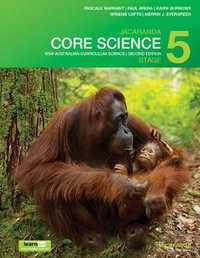About this book viii
Acknowledgements xi
1 Investigating 1
1.1 Overview 1
1.2 What do scientists do? 4
1.3 The science laboratory 7
1.4 Observing and inferring 14
1.5 Reporting on investigations 22
1.6 Designing investigations 29
1.7 Famous scientists 34
1.8 Project: An inspiration for the future 37
1.9 Review 39
2 Cells — the building blocks of life 46
2.1 Overview 46
2.2 Using a microscope 47
2.3 The right tool for the job 52
2.4 A whole new world! 55
2.5 Living things are made of cells 58
2.6 What a cell needs! 62
2.7 One cell or more? 68
2.8 Cells getting organized 71
2.9 Cells of all shapes and sizes 73
2.10 Focus on plants 76
2.11 Review 78
3 States of matter 83
3.1 Overview 83
3.2 What’s the matter? 85
3.3 The particle model 87
3.4 A solid performance 91
3.5 Going with the flow 94
3.6 Changing states 98
3.7 Density 105
3.8 Expansion and contraction 109
3.9 Under pressure! 113
3.10 Plasma — the fourth state of matter 116
3.11 Review 117
4 Classification 122
4.1 Overview 122
4.2 Why classify? 124
4.3 Is it alive? 127
4.4 Identification keys 132
4.5 Classifying small living things 135
4.6 Classification of animals using structural features 140
4.7 Meet the vertebrates 143
4.8 Surviving in the Australian environment 147
4.9 Classifying plants 151
4.10 Project: Snakes alive! 155
4.11 Review 156
5 Separating mixtures 160
5.1 Overview 160
5.2 Pure substances and mixtures 162
5.3 Looking for solutions 166
5.4 Mixing insoluble substances 170
5.5 Separate ways 172
5.6 Separating blood 176
5.7 Separating solutions 179
5.8 Down the S-bend 186
5.9 Fit to drink? 188
5.10 Project: The diamond flush 192
5.11 Review 193
6 The solar system 198
6.1 Overview 198
6.2 Voyage to the planets 200
6.3 A very important star 208
6.4 Rocks in space 211
6.5 The Earth in motion 214
6.6 The moon in motion 218
6.7 Lunar and solar eclipses 225
6.8 Early ideas in astronomy 228
6.9 Review 236
7 Forces in action 241
7.1 Overview 241
7.2 What are forces? 242
7.3 Friction 247
7.4 Magnetic forces 253
7.5 Electrostatic forces 261
7.6 Gravitational forces 267
7.7 Buoyancy and surface tension 273
7.8 Using technology to reduce the impact of forces 277
7.9 Review 281
8 Body systems 286
8.1 Overview 286
8.2 All systems go! 288
8.3 Taking in nutrients 292
8.4 The digestive system 298
8.5 Physical or chemical digestion? 302
8.6 Dietary deficiencies — one problem, many opinions 305
8.7 Breathe in, breathe out 309
8.8 Blood highways 314
8.9 Have a heart 318
8.10 Getting rid of waste 324
8.11 Bodies on the move 328
8.12 Review 333
9 The structure and properties of matter 338
9.1 Overview 338
9.2 The history of the atom 340
9.3 The structure of the atom 344
9.4 It’s elementary! 347
9.5 Grouping elements 351
9.6 Compounds 355
9.7 Making molecules 359
9.8 Polymers 362
9.9 Mixed-up metals 364
9.10 Carbon — the stuff of life 367
9.11 Project: Science TV 370
9.12 Review 372
10 The changing Earth 377
10.1 Overview 377
10.2 Solid rock 380
10.3 Fiery rocks 383
10.4 Wearing away 388
10.5 It’s sedimentary, Watson! 392
10.6 Time trapped in rocks 396
10.7 Rocky changes 400
10.8 Human-made erosion 404
10.9 Review 407
11 Energy 412
11.1 Overview 412
11.2 Energy transfers and transformations 414
11.3 Heat and temperature 420
11.4 Using electrical energy 430
11.5 Technological solutions to energy efficiency 444
11.6 Project: Going green 452
11.7 Review 454
12 Chemical changes 458
12.1 Overview 458
12.2 Time for a change? 460
12.3 Describing chemical changes 464
12.4 Faster and slower 468
12.5 Rusting is a chemical reaction 473
12.6 Feel the burn 476
12.7 Acids and bases 479
12.8 Acid rain 484
12.9 Review 489
13 From one to many 494
13.1 Overview 494
13.2 Multiplying by dividing 496
13.3 Out of control! 500
13.4 Plant parts 506
13.5 Leafy exchanges 510
13.6 The sex life of plants 516
13.7 Plants and parenthood 519
13.8 Plant research project 522
13.9 All about the birds and bees 526
13.10 Where do babies come from? 529
13.11 Womb with a view 534
13.12 Review 539
14 Earth’s precious resources 545
14.1 Overview 545
14.2 Nature’s resources 547
14.3 Extracting fossil fuels 550
14.4 Using fossil fuels 553
14.5 Make mine renewable 558
14.6 Mining for metals 560
14.7 Mining and the environment 563
14.8 Using metals 567
14.9 Avoid, re-use or recycle 570
14.10 Water world 574
14.11 Water management 577
14.12 Review 582
15 Ecology 587
15.1 Overview 587
15.2 A place to call home 589
15.3 Who’s hungry? 594
15.4 Caught in a web 596
15.5 Antarctica — the last frontier 599
15.6 Friendly microbes 606
15.7 Call in the decomposers 609
15.8 Extreme weather ahead 614
15.9 A fiery start 620
15.10 Using science to improve agricultural practices 624
15.11 Project: Small acts, big changes 630
15.12 Review 631
16 Health science 635
16.1 Overview 635
16.2 Looking for patterns to address health issues 637
16.3 Discovering germs 642
16.4 Germs all around us 646
16.5 A weapon against bacteria 649
16.6 A little knowledge goes a long way 653
16.7 Bacteria at your service 659
16.8 Replacement parts 663
16.9 Healthy careers 667
16.10 Review 671
17 Student research project and skills 675
17.1 Overview 675
17.2 Choosing a problem 677
17.3 Thinking about your problem 681
17.4 Organising your thinking 687
17.5 Research and record keeping 691
17.6 Designing your method 694
17.7 Presenting your results 699
17.8 Using technology: spreadsheets 707
17.9 Using technology: databases 709
17.10 Writing your report 712
17.11 Project: Bigger, better beans 715
17.12 Review 715
Glossary 719
Index 736


